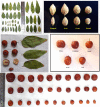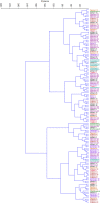Identification of superior jujube (Ziziphus jujuba Mill.) genotypes based on morphological and fruit characterizations
- PMID: 34136181
- PMCID: PMC8194938
- DOI: 10.1002/fsn3.2276
Identification of superior jujube (Ziziphus jujuba Mill.) genotypes based on morphological and fruit characterizations
Abstract
Jujube (Ziziphus jujuba Mill.) is of great importance due to its medicinal properties and nutritional value. The current investigation was carried out to assess phenotypic variation of naturally grown accessions of this species. The accessions investigated exhibited meaningful variabilities based on the recorded characters. Fruit fresh weight ranged from 0.36 to 3.83 g with an average of 1.16, fruit dry weight varied from 0.21 to 3.04 g with an average of 0.80, and fruit flesh thickness varied from 1.24 to 8.51 mm. Skin color showed large variabilities among the accessions, including maroon-yellow, light maroon, maroon, dark maroon, light brown, brown, dark brown, and maroon-crimson. Principal component analysis (PCA) determined the characters influencing the most variation among the accessions. Cluster analysis performed with the Euclidean distance and Ward's method divided the accessions into two main clusters. The present findings provided essential data about the morphological traits of Z. jujube that can be used for the selection of superior genotypes and development of the fruit processing industry. Besides, the available results can be useful in designing conservation strategies and breeding of Z. jujube.
Keywords: breeding; conservation; fruit; jujube; medicinal properties.
© 2021 The Authors. Food Science & Nutrition published by Wiley Periodicals LLC.
Conflict of interest statement
The authors declare no conflict of interest.
Figures




Similar articles
-
Morphological characterization and interspecific variation among five species of Ziziphus genus to select superiors in Iran.BMC Plant Biol. 2023 Nov 8;23(1):550. doi: 10.1186/s12870-023-04566-4. BMC Plant Biol. 2023. PMID: 37936089 Free PMC article.
-
Selection of superior genotypes of Indian jujube (Ziziphus mauritiana Lamk.) as revealed by fruit-related traits.Food Sci Nutr. 2022 Jan 17;10(3):903-913. doi: 10.1002/fsn3.2721. eCollection 2022 Mar. Food Sci Nutr. 2022. PMID: 35311171 Free PMC article.
-
Morphological and chemical characterizations of jujube (Ziziphus jujuba Mill.) to select superior accessions.Food Sci Nutr. 2022 Mar 21;10(7):2213-2223. doi: 10.1002/fsn3.2831. eCollection 2022 Jul. Food Sci Nutr. 2022. PMID: 35844916 Free PMC article.
-
Research progress on extraction, separation, structure, and biological activities of polysaccharides from jujube fruit (Ziziphus jujuba Mill.): a review.Front Chem. 2025 Apr 16;13:1581947. doi: 10.3389/fchem.2025.1581947. eCollection 2025. Front Chem. 2025. PMID: 40308264 Free PMC article. Review.
-
The jujube (Ziziphus jujuba Mill.) fruit: a review of current knowledge of fruit composition and health benefits.J Agric Food Chem. 2013 Apr 10;61(14):3351-63. doi: 10.1021/jf4007032. Epub 2013 Mar 28. J Agric Food Chem. 2013. PMID: 23480594 Review.
Cited by
-
Multiple-Genome-Based Simple Sequence Repeat Is an Efficient and Successful Method in Genotyping and Classifying Different Jujube Germplasm Resources.Plants (Basel). 2023 Aug 7;12(15):2885. doi: 10.3390/plants12152885. Plants (Basel). 2023. PMID: 37571038 Free PMC article.
-
Morphological characterization and interspecific variation among five species of Ziziphus genus to select superiors in Iran.BMC Plant Biol. 2023 Nov 8;23(1):550. doi: 10.1186/s12870-023-04566-4. BMC Plant Biol. 2023. PMID: 37936089 Free PMC article.
-
Identification of the promising olive (Olea europaea L.) cultivars based on morphological and pomological characters.Food Sci Nutr. 2022 Feb 7;10(4):1299-1311. doi: 10.1002/fsn3.2767. eCollection 2022 Apr. Food Sci Nutr. 2022. PMID: 35432970 Free PMC article.
-
Selection of superior late-blooming almond (Prunus dulcis [Mill.] D.A.Webb) genotypes using morphological characterizations.Food Sci Nutr. 2023 Apr 21;11(7):3844-3857. doi: 10.1002/fsn3.3370. eCollection 2023 Jul. Food Sci Nutr. 2023. PMID: 37457173 Free PMC article.
-
Selection of superior genotypes of Indian jujube (Ziziphus mauritiana Lamk.) as revealed by fruit-related traits.Food Sci Nutr. 2022 Jan 17;10(3):903-913. doi: 10.1002/fsn3.2721. eCollection 2022 Mar. Food Sci Nutr. 2022. PMID: 35311171 Free PMC article.
References
-
- Almansa, S. , Hernandez, F. , Legua, P. , Nicolas‐Almansa, M. , & Amoros, A. (2016). Physicochemical and physiological changes during fruit development and on‐tree ripening of two Spanish jujube cultivars (Ziziphus jujuba Mill.). Journal of the Science of Food and Agriculture, 96, 4098–4105. - PubMed
-
- Awasthi, O. P. , & More, T. A. (2009). Genetic diversity and status of Ziziphus in India. Acta Horticulturae, 840, 33–40. 10.17660/ActaHortic.2009.840.2 - DOI
-
- Azam‐Ali, S. , Bonkoungou, E. , Bowe, C. , DeKock, C. , Godara, A. , & Williams, J. T. (2001). Fruits for the future (Revised Edition), ber and other jujubes. nternational Centre for Underutilized Crops, University of Southampton, .
-
- Brindza, J. , Karnatovska, M. , Grygorieva, O. , Vietoris, V. , Kucelova, L. , & Erdelyova, G. (2011). Morphological and organoleptic nature of Ziziphus jujuba Mill. Potravinarstvo, 5, 1–11.
-
- Choi, S. H. , Ahn, J. B. , Kozukue, N. , Levin, C. E. , & Friedman, M. (2011). Distribution of free amino acids, flavonoids, total phenolics, and antioxidative activities of jujube (Ziziphus jujuba) fruits and seeds harvested from plants grown in Korea. Journal of Agriculture and Food Chemistry, 59, 6594–6604. - PubMed
LinkOut - more resources
Full Text Sources

